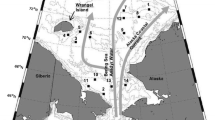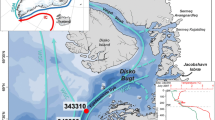Abstract
Currently, the impact of declining seasonal sea ice extent in the Arctic on polar food webs remains uncertain. Previously, a range of proxy techniques has been employed to determine links between sea ice or phytoplankton primary production and the Arctic marine food web, although it is accepted that such approaches have their limitations. Here, we propose a novel approach to tracing sea ice primary production through Arctic food webs using the sea ice diatom biomarker, IP25. Various benthic macrofaunal specimens were collected between March and May 2008 from Franklin Bay in the Amundsen Gulf, Arctic Canada, as part of the International Polar Year–Circumpolar Flaw Lead system study. Each specimen was analysed for the presence of the sea ice diatom biomarker IP25 in order to provide evidence for feeding by benthic organisms on sea ice algae. IP25 was found in nineteen out of the twenty-one specimens analysed, often as the most abundant of the highly branched isoprenoid biomarkers detected. The stable isotope composition of IP25 (δ13C = −17.1 ± 0.5‰) in the sea urchin (Strongylocentrotus sp.) specimens was similar to that reported previously for this biomarker in Arctic sea ice, sedimenting particles and sediments. It is concluded that detection of IP25 in Arctic benthic macrofauna represents a novel approach to providing convincing evidence for feeding on sea ice algae. It is also proposed that analysis of IP25 may be used to trace trophic transfer of sea ice algal-derived organic matter through Arctic food webs in the future.


Similar content being viewed by others
References
Allard WG, Belt ST, Massé G, Naumann R, Robert JM, Rowland SJ (2001) Tetra-unsaturated sesterterpenoids (Haslenes) from Haslea ostrearia and related species. Phytochemistry 56:795–800
Ambrose WG, Renaud PE (1997) Does a pulsed food supply to the benthos affect polychaete recruitment patterns in the Northeast Water Polynya? J Mar Syst 10:483–495
Andrews JT, Belt ST, Olafsdottir S, Massé G, Vare LL (2009) Sea ice and marine climate variability for NW Iceland/Denmark Strait over the last 2000 cal. yr BP. Holocene 19:775–784
Arrigo KR, Mock T, Lizotte MP (2010) Primary producers and sea ice. In: Thomas DN, Dieckmann GS (eds) Sea ice: second edition. Blackwell, Oxford, pp 283–325
Belt ST, Cooke DA, Robert JM (1996) Structural characterisation of widespread polyunsaturated isoprenoid biomarkers: a C25 triene, tetraene and pentaene from the diatom Haslea ostrearia simonsen. Tetrahedron Lett 37:4755
Belt ST, Allard WG, Massé G, Robert JM, Rowland SJ (2000) Important sedimentary sesterterpenoids from the diatom Pleurosigma intermedium. Chem Commun 501–502
Belt ST, Allard WG, Massé G, Robert JM, Rowland SJ (2001a) Structural characterisation of C30 highly branched isoprenoid alkenes (rhizenes) in the marine diatom Rhizosolenia setigera. Tetrahedron Lett 42:5583–5585
Belt ST, Massé G, Allard WG, Robert JM, Rowland SJ (2001b) C25 highly branched isoprenoid alkenes in planktonic diatoms of the Pleurosigma genus. Org Geochem 32:1271–1275
Belt ST, Massé G, Allard WG, Robert JM, Rowland SJ (2001c) Identification of a C25 highly branched isoprenoid triene in the freshwater diatom Navicula sclesvicensis. Org Geochem 32:1169–1172
Belt ST, Massé G, Allard WG, Robert JM, Rowland SJ (2002) Effects of auxosporulation on distributions of C25 and C30 isoprenoids alkenes in Rhizosolenia setigera. Phytochemistry 59:141–148
Belt ST, Massé G, Rowland SJ, Poulin M, Michel C, LeBlanc B (2007) A novel chemical fossil of palaeo sea ice: IP25. Org Geochem 38:16–27
Belt ST, Massé G, Vare LL, Rowland SJ, Poulin M, Sicre M-A, Sampei M, Fortier L (2008) Distinctive 13C isotopic signature distinguishes a novel sea ice biomarker in Arctic sediments and sediment traps. Mar Chem 112:158–167
Belt ST, Vare LL, Massé G, Manners H, Price J, MacLachlan S, Andrews JT, Schmidt S (2010) Striking similarities in temporal changes to seasonal sea ice conditions across the central Canadian Arctic Archipelago during the last 7, 000 years. Quat Sci Rev 29:3489–3504
Brown T, Belt ST, Philippe B, Mundy CJ, Massé G, Poulin M, Gosselin M (2011) Temporal and vertical variations of lipid biomarkers during a bottom ice diatom bloom in the Canadian Beaufort Sea: further evidence for the use of the IP25 biomarker as a proxy for spring Arctic sea ice. Polar Biol. doi:10.1007/s00300-010-0942-5
Carroll ML, Carroll J (2003) The Arctic seas. In: Black KD, Shimmield GB (eds) Biogeochemistry of marine systems. Blackwell, Oxford, pp 126–156
Cota GF (1985) Photoadaptation of high Arctic ice algae. Nature 315:219–222
Dieckmann GS, Hellmer HH (2010) The importance of sea ice: an overview. In: Thomas D, Dieckmann S (eds) Sea ice (second edition). Blackwell, Chichester, pp 1–22
Falk-Petersen S, Haug T, Hop H, Nilssen KT, Wold A (2009) Transfer of lipids from plankton to blubber of harp and hooded seals off East Greenland. Deep Sea Res Pt II 56:2080–2086
France RL (1995) Carbon-13 enrichment in benthic compared to planktonic algae: foodweb implications. Mar Ecol Prog Ser 124:307–312
Fry B, Wainright SC (1991) Diatom sources of 13C-rich carbon in marine food webs. Mar Ecol Prog Ser 76:149–157
Gosselin M, Levasseur M, Wheeler PA, Horner RA, Booth BC (1997) New measurements of phytoplankton and ice algal production in the Arctic Ocean. Deep Sea Res Pt II 44:1623–1644
Hobson KA, Welch HE (1992) Determination of trophic relationships within a high Arctic marine food web using δ13C and δ15N analysis. Mar Ecol Prog Ser 84:9–18
Hobson KA, Ambrose WG Jr, Renaud PE (1995) Sources of primary production, benthic-pelagic coupling, and trophic relationships within the Northeast Water Polynya: insights from δ13C and δ15N analysis. Mar Ecol Prog Ser 128:1–10
Johns L, Wraige EJ, Belt ST, Lewis CA, Massé G, Robert JM, Rowland SJ (1999) Identification of a C25 highly branched isoprenoid (HBI) diene in Antarctic sediments, Antarctic sea-ice diatoms and cultured diatoms. Org Geochem 30:1471–1475
Legendre L, Ackley S, Diekmann G, Gulliksen B, Horner R, Hoshiai T, Melnikov I, Reeburgh W, Spindler M, Sullivan C (1992) Ecology of sea ice biota 2. Global significance. Polar Biol 12:429–444
Lovvorn JR, Cooper LW, Brooks ML, De Ruyck CC, Bump JK, Grebmeier JM (2005) Organic matter pathways to zooplankton and benthos under pack ice in late winter and open water in late summer in the north-central Bering Sea. Mar Ecol Prog Ser 291:135–150
Massé G, Belt ST, Allard GW, Lewis CA, Wakeham SG, Rowland SJ (2004) Occurrence of novel monocyclic alkenes from diatoms in marine particulate matter and sediments. Org Geochem 35:813–822
Massé G, Rowland SJ, Sicre M-A, Jacob J, Jansen E, Belt ST (2008) Abrupt climate changes for Iceland during the last millennium: evidence from high resolution sea ice reconstructions. Earth Planet Sci Lett 269:565–569
McMahon KW, Ambrose WG Jr, Johnson BJ, Yi Sun M, Lopez GR, Clough LM, Carroll ML (2006) Benthic community response to ice algae and phytoplankton in Ny Ålesund, Svalbard. Mar Ecol Prog Ser 310:1–14
Morata N, Poulin M, Renaud PE (2010) A multiple biomarker approach to tracking the fate of an ice algal bloom to the sea floor. Polar Biol 34:101–112
Müller J, Massé G, Stein R, Belt ST (2009) Variability of sea-ice conditions in the Fram Strait over the past 30,000 years. Nat Geosci 2:772–776
Mundy CJ, Barber DG, Michel C (2005) Variability of snow and ice thermal, physical and optical properties pertinent to sea ice algae biomass during spring. J Mar Syst 58:107–120
Mundy CJ, Gosselin M, Ehn J, Gratton Y, Rossnagel A, Barber DG, Martin J, Tremblay J-E, Palmer M, Arrigo KR, Darnis Gr, Fortier L, Else B, Papakyriakou T (2009) Contribution of under-ice primary production to an ice-edge upwelling phytoplankton bloom in the Canadian Beaufort Sea. Geophys Res Lett 36. doi:10.1029/2009gl038837
Nichols PD, Palmisano AC, Volkman JK, Smith GA, White DC (1988) Occurrence of an isoprenoid C25 diunsaturated alkene and high neutral lipid content in Antarctic sea-ice diatom communities. J Phycol 24:90–96
Piepenburg D (2005) Recent research on Arctic benthos: common notions need to be revised. Polar Biol 28:733–755
Reuss N, Poulsen LK (2002) Evaluation of fatty acids as biomarkers for a natural plankton community. A field study of a spring bloom and a post-bloom period off West Greenland. Mar Biol 141:423–434
Rontani J-F, Belt ST, Vaultier F, Brown TA (2011) Visible light induced photo-oxidation of highly branched isoprenoid (HBI) alkenes: significant dependence on number and nature of double bonds. Org Geochem. doi:10.1016/j.orggeochem.2011.04.013
Rowland SJ, Belt ST, Wraige EJ, Masse G, Roussakis C, Robert JM (2001) Effects of temperature on polyunsaturation in cytostatic lipids of Haslea ostrearia. Phytochemistry 56:597–602
Różanska M, Gosselin M, Poulin M, Wiktor JM, Michel C (2009) Influence of environmental factors on the development of bottom ice protist communities during the winter-spring transition. Mar Ecol Prog Ser 386:43–59
Sakshaug E (2004) Primary and secondary production the Arctic Seas. In: Stein R, Macdonald RW (eds) The organic carbon cycle in the Arctic Ocean. Springer, London
Sinninghe Damsté JS, Schouten S, Rijpstra WIC, Hopmans EC, Peletier H, Gieskes WWC, Geenevasen JAJ (1999) Structural identification of the C25 highly branched isoprenoid pentaene in the marine diatom Rhizosolenia setigera. Org Geochem 30:1581–1583
Tamelander T, Kivimäe C, Bellerby RGJ, Renaud PE, Kristiansen S (2009) Base-line variations in stable isotope values in an Arctic marine ecosystem: effects of carbon and nitrogen uptake by phytoplankton. Hydrobiologia 630:63–73
Tiselius P, Kuylenstierna B (1996) Growth and decline of a diatom spring bloom phytoplankton species composition, formation of marine snow and the role of heterotrophic dinoflagellates. J Plankton Res 18:133–155
Vare LL, Massé G, Gregory TR, Smart CW, Belt ST (2009) Sea ice variations in the central Canadian Arctic Archipelago during the Holocene. Quat Sci Rev 28:1354–1366
Vare LL, Massé G, Belt ST (2010) A biomarker-based reconstruction of sea ice conditions for the Barents Sea in recent centuries. Holocene 20:637–643
Volkman JK, Barrett SM, Dunstan GA (1994) C25 and C30 highly branched isoprenoid alkenes in laboratory cultures of two marine diatoms. Org Geochem 21:407–414
Wassmann P, Andreassen I, Reigstad M, Slagstad D (1996) Pelagic-benthic coupling in the Nordic Seas: the role of episodic events. Mar Ecol 17:447–471
Wraige EJ, Johns L, Belt S, Massé G, Robert J-M, Rowland S (1999) Highly branched C25 isoprenoids in axenic cultures of Haslea ostrearia. Phytochemistry 51:69–73
Acknowledgments
We thank the Natural Environment Research Council (NERC, UK) for funding part of this work (NE/D013216/1, LSMSBRIS026_04/08) and, in particular, for providing a PhD studentship to T.B. (NE/F007043/1). Partial operating funds for the CCGS Amundsen were provided by the International Joint Ventures Fund of the Canada Foundation for Innovation. We would like to extend our gratitude to the officers and crew of the CCGS Amundsen for their invaluable support during the expedition. We thank Dr. I. Bull and J. Williams from the University of Bristol for analyses of stable carbon isotopes by GC/C/IRMS. We are also grateful to Paul Renaud and two anonymous reviewers for making suggestions on improving the focus of this paper. This work is a contribution to the International Polar Year-Circumpolar Flaw Lead system study (IPY-CFL).
Author information
Authors and Affiliations
Corresponding author
Rights and permissions
About this article
Cite this article
Brown, T.A., Belt, S.T. Identification of the sea ice diatom biomarker IP25 in Arctic benthic macrofauna: direct evidence for a sea ice diatom diet in Arctic heterotrophs. Polar Biol 35, 131–137 (2012). https://doi.org/10.1007/s00300-011-1045-7
Received:
Revised:
Accepted:
Published:
Issue Date:
DOI: https://doi.org/10.1007/s00300-011-1045-7




